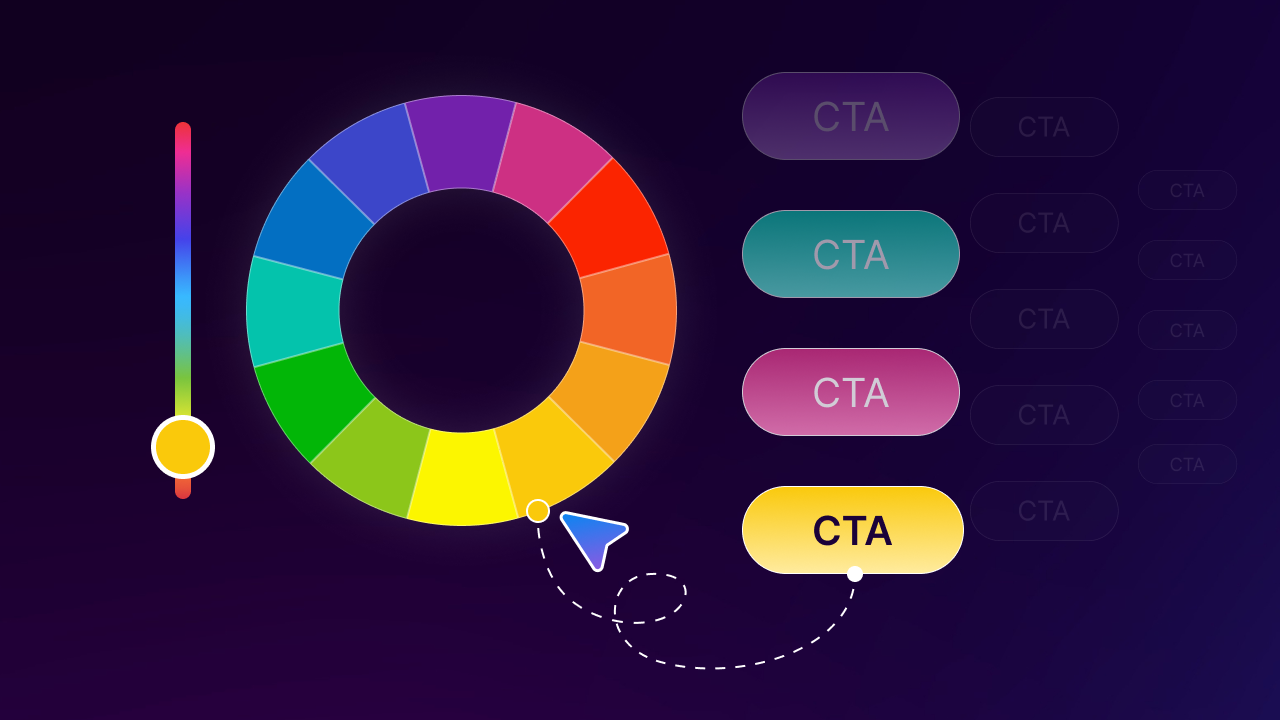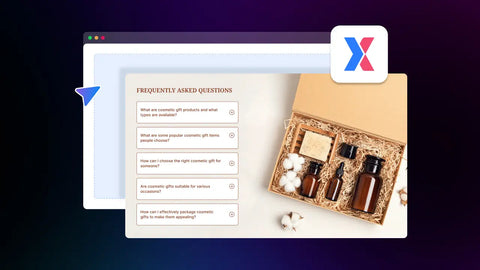The core idea
A Shopify store selling premium cotton t-shirts. Its flagship product, the Classic Cotton T-Shirt, is displayed with high-resolution images, detailed descriptions, and a bright red “Add to Cart” button. Despite attracting around 10,000 visitors per month, only 2% of them complete a purchase.
Heatmap simulations and session recordings reveal a pattern: visitors engage with product images and read descriptions carefully, but hesitate when encountering the red CTA. Many scroll back and forth, comparing product features, and eventually leave without clicking.
This hesitation represents a critical drop-off point: lost revenue from users who were clearly interested but were subconsciously stalled at the final step.
This scenario is common in eCommerce: businesses invest heavily in driving traffic but overlook micro-conversions, the small interactions that ultimately determine purchase behavior.
Here, the CTA button is a micro-interaction with outsized potential leverage, yet its color and placement may unintentionally impede user action. The challenge is to identify a high-impact, low-cost optimization that nudges users toward purchase without overhauling the entire page.
The Hypothesis
Hypothesis Formation
|
IF the CTA button is changed from red to green,
THEN the conversion rate will increase,
BECAUSE green conveys positivity, safety, and a “go” signal, reducing hesitation and encouraging action. |
On the surface, this sounds trivial. “Change a color, get more sales.” But this is a behavioral science play: Humans don’t process visuals rationally. Before we even read what a button says, our brain assigns emotional meaning to its color.
Red can trigger avoidance tendencies and caution, particularly when committing to an action like a purchase. Green, on the other hand, activates approach-oriented behavior, signaling progress and safety.
In other words, the button is a behavioral cue that guides the visitor’s decision-making process.
Psychological Triggers and Research Insights
Decades of cognitive and behavioral research confirm that color modifies perception, emotion, and even physical response time.
1. Approach-Avoidance Theory in Action
The approach-avoidance framework explains human decision-making as a tension between moving toward rewards or away from risks.
-
Red amplifies risk sensitivity — it signals “alert,” “stop,” or “warning.”
-
Green promotes approach behavior — “go,” “safe,” “confirm.”
2. The Pre-Attentive Effect
Before users consciously decide to act, their visual cortex prioritizes elements based on color, shape, and contrast. Green has a calming yet directive effect; it draws attention without aggression. That balance makes it ideal for high-stakes actions like “Buy Now.”
3. The UX-Behavior Connection
A study published in the Journal of Consumer Psychology found that colors congruent with the intended action (e.g., green for “go”) increase click-through rates by up to 25%. The reason: congruence between color meaning and task reduces cognitive load — the mental effort needed to decide.
The implication is profound: users don’t want to think about your design. They want to act instinctively, and your design should give them permission to do so.
Case Study: The Performable Experiment
When Performable, a marketing automation company, redesigned its homepage, the team debated a simple question:
“Can a button’s color really change conversions?”
Their primary CTA, Get Started Now, was bright green — aligned with their brand and intuitively symbolizing “go.” But engagement data showed lower-than-expected clicks.
The Test
They set up an A/B test with two identical versions:
-
Version A (Control): Green CTA button
-
Version B (Variant): Same layout, but with a red CTA button
No copy, layout, or offer changes, only the button color. Traffic was evenly split.

Case study via Optinmonk.
The Results
Within days, the red button outperformed green by 21% in click-through rate.
Why? On a muted green interface, the red CTA stood out as the visual anchor.
While green signals “go,” it blended in too well.
Red, despite its “stop” association, captured attention and urgency, driving immediate action.
Replicating This with GemX
If you’re running a Shopify store with GemPages, this kind of test takes minutes to set up in GemX:
-
Clone your product page.
-
Change only the CTA color (e.g., from red to green or vice versa).
-
Use GemX to split traffic evenly, set your conversion goals, and start tracking.
Within one to two weeks, GemX will show whether your “go” color truly encourages users to go, or whether a contrasting hue drives stronger action.
A/B Testing Setup with GemX
Here’s how to recreate the “CTA color” experiment in just a few minutes:
Step 1: Select Control Template
The goal of this step is to create two identical page templates, with the only difference being the CTA button color.
Start by identifying the product page with the red CTA you want to test.
This will serve as Version A (Control) — the original version that customers currently see.

Step 2: Select Variant Template
GemX supports both Shopify native pages and GemPages-built pages, so your setup will differ slightly depending on your store’s setup:
If you’re using GemPages
You can duplicate your control template directly inside GemX, without leaving the app.
In the “Select Variant Template” section, choose “Create Variant based on Control”. GemX will automatically create Version B and take you straight to the GemPages Editor.

Change its button color — for example, from red to green.


If you’re using other page builders (not GemPages)
You’ll need to prepare the two templates beforehand: one serving as Version A (control) and the other as Version B (variant).
GemX will then pull the available templates from your store, allowing you to select both versions for your experiment setup.
Save Version B when done. Once both templates are ready, proceed to the next step to configure your test settings.

Step 3: Configure Advanced Experiment Settings
Once both templates are ready, navigate to Experiment Settings in GemX.
Here, you’ll define how your traffic, metrics, and targeting work behind the scenes.
For this CTA color test, the goal is to measure which version drives more completed purchases while keeping the experiment simple and controlled.
1. Winning Metric
Choose the main goal that determines success:
-
Conversion (Recommended): Since the hypothesis focuses on whether a different CTA color encourages more purchases, conversion rate is the most direct and reliable indicator.
-
Revenue: You can enable this as a winning metric to observe whether the color change also influences order value, but it’s not essential for this specific test.

Why this choice: CTA color primarily impacts user action intent — not pricing or basket size — so Conversion Rate is the most accurate measure of success.
2. Device Targeting
Select All Devices (recommended).

This ensures that both desktop and mobile visitors are included in the test, giving you a holistic understanding of user behavior across screens.
Why this choice: Color perception can differ by device type (e.g., greens appear darker on some mobile screens), so capturing all devices provides a complete performance picture. Later, you can segment results by device inside the GemX dashboard.
3. Visitor Type
Choose All Visitors (recommended) to include both new and returning users.

Why this choice: The color of your CTA affects the instinctive decision to click, a behavior influenced by design, not familiarity. Including all visitors gives your results stronger statistical power and ensures generalizability across your audience.
4. Traffic Source
Select All Traffic Sources (Recommended) to begin with a broad, representative sample.

GemX supports advanced filtering by source (Direct, Email, Referral, Organic Social, Organic Search, Paid Social, Paid Search, SMS), but for a color-based experiment, start broad unless you have a specific campaign goal.
Why this choice: The impact of color on click behavior is universal across acquisition channels. Restricting sources too early could skew your data due to sample size limitations.
5. Traffic Split
Set your Traffic Split to 50/50 to ensures that 50% of visitors see Version A (red CTA) and 50% see Version B (green CTA).

GemX automatically randomizes visitors and applies persistent session mapping, meaning returning users always see the same version they were first exposed to.
Why this choice: A 50/50 split balances statistical efficiency with fairness. Both versions reach similar audience sizes, reducing bias and ensuring your results are trustworthy within 1–2 weeks.
6. Market & Language
Choose the primary market and language that represent your store’s main audience (for example, United States – English).

Why this choice: Color perception can vary across cultures — red may symbolize urgency in the U.S. but luck or celebration in Asia. Testing within your main market keeps the data consistent and contextually accurate.
Once you’ve configured these options, save your setup and launch the experiment.
GemX will begin evenly distributing traffic, tracking conversions, and collecting behavioral insights in real time, so you can see, within days, whether your “go” color truly makes users go.
Interpreted Results — What to look for
When the test completes, combine quantitative and qualitative signals:
-
Primary KPI movement: Did conversion rate increase? By how many absolute and relative percentage points? Convert relative lifts to projected monthly revenue gains for the business context.
-
CTA click behavior: Did click‑throughs on the CTA increase? If yes, did that lift translate to purchases or only early engagement?
-
Downstream metrics: Watch for changes in AOV and checkout abandonment. A color that increases clicks but also increases returns or cancellations should be scrutinized.
-
Behavioral signals: Heatmaps and session recordings might reveal reduced hesitation (fewer returns to price or description) on the winning variant.
-
Segmented impact: Analyze by device (desktop vs mobile), traffic source, and new vs returning visitors. Colors and contrast can behave differently across segments.
Example interpretation: a switch from red to green yields a 32% relative lift in conversion rate (from 2.0% to 2.64%). At 10,000 monthly sessions and an average order value of $45, that lift corresponds to an additional 64 purchases and an incremental $2,880 monthly revenue.
Why use GemX for this test?
GemX streamlines experiment setup and measurement for product pages:
-
Template cloning lets you create identical variants quickly.
-
Built‑in traffic allocation ensures unbiased randomization and persistent user assignment.
-
Event tracking and dashboards provide both headline metrics and session‑level data for deep analysis.
-
Heatmaps & recordings are co‑located with experiment results, removing the need for multiple tools and speeding insight loops.
In short, GemX turns a behavioral hypothesis into a repeatable, measurable experiment without heavy engineering overhead.











